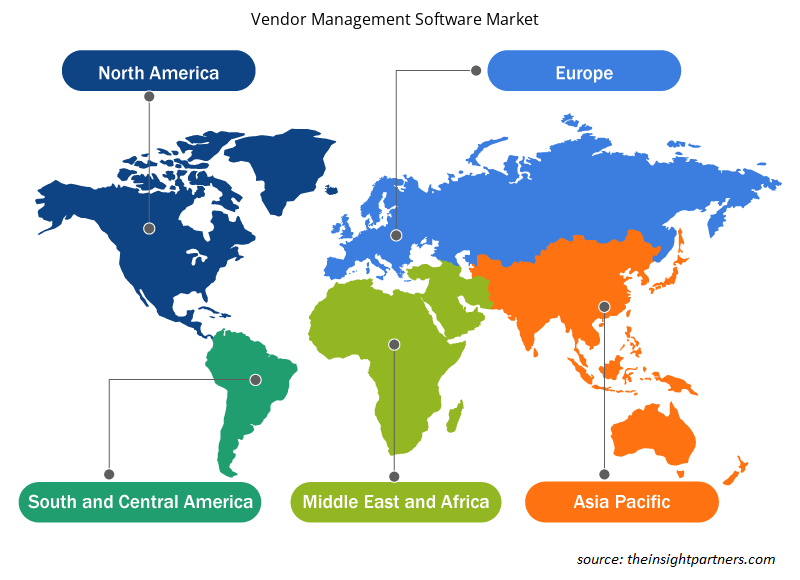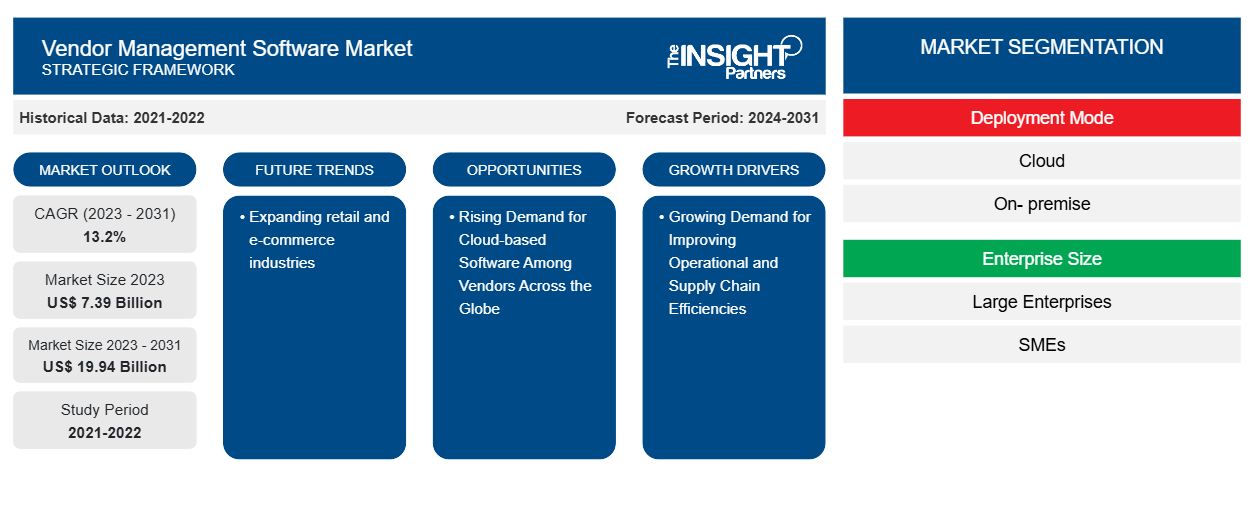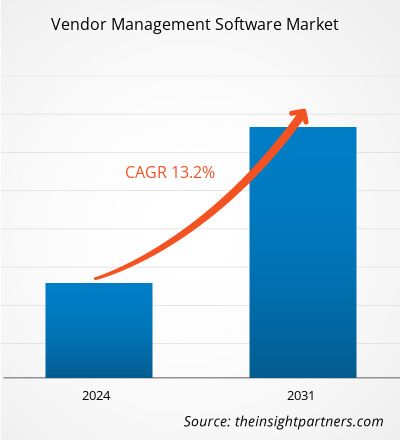Der Markt für Lieferantenmanagementsoftware soll von 7,39 Milliarden US-Dollar im Jahr 2023 auf 19,94 Milliarden US-Dollar im Jahr 2031 anwachsen. Der Markt soll zwischen 2023 und 2031 eine durchschnittliche jährliche Wachstumsrate (CAGR) von 13,2 % verzeichnen. Die Expansion des Einzelhandels und des E-Commerce wird voraussichtlich ein wichtiger Trend auf dem Markt für Lieferantenmanagementsoftware bleiben.
Marktanalyse für Lieferantenmanagementsoftware
Der Markt für Lieferantenmanagementsoftware wächst rasant aufgrund der steigenden Nachfrage nach verbesserter Betriebs- und Lieferketteneffizienz sowie bedeutender staatlicher Initiativen zur Förderung der Entwicklung von KMU durch Cloud-Einführung. Der Markt wächst stetig, angetrieben von der steigenden Nachfrage der Lieferanten nach technologisch fortschrittlicher und kostengünstiger Software. Darüber hinaus bieten die steigende Nachfrage der Lieferanten weltweit nach Cloud-basierter Software und die zunehmende Komplexität bei der Verwaltung der Beziehungen zu vielen Lieferanten lukrative Möglichkeiten für Marktwachstum.
Marktübersicht für Lieferantenmanagementsoftware
Das Lieferantenmanagement umfasst die Entwicklung und Pflege von Beziehungen zu Lieferanten von Waren und Dienstleistungen, die für den täglichen Betrieb erforderlich sind. Lieferantenmanagementsoftware ist eine Softwareanwendung, die von Lieferanten zur angemessenen Verwaltung ihrer Lieferkette oder Vertriebsnetzwerke verwendet wird. Der wachsende Bedarf von Unternehmen, Risiken zu reduzieren und schnellere Entscheidungen zu treffen, schafft Wachstumschancen für den Markt für Lieferantenmanagementsoftware.
Passen Sie diesen Bericht Ihren Anforderungen an
Sie erhalten kostenlose Anpassungen an jedem Bericht, einschließlich Teilen dieses Berichts oder einer Analyse auf Länderebene, eines Excel-Datenpakets sowie tolle Angebote und Rabatte für Start-ups und Universitäten.
- Holen Sie sich die wichtigsten Markttrends aus diesem Bericht.Dieses KOSTENLOSE Beispiel umfasst eine Datenanalyse von Markttrends bis hin zu Schätzungen und Prognosen.
Treiber und Chancen auf dem Markt für Lieferantenmanagementsoftware
Wachsende Nachfrage nach Verbesserung der Betriebs- und Lieferketteneffizienz treibt den Markt an
Der zunehmende Einsatz von Hightech-Software in verschiedenen Unternehmen zur Optimierung von Geschäftsprozessen treibt die Installation von Lieferantenmanagementsystemen voran. Unternehmen konzentrieren sich zunehmend auf die Automatisierung ihrer Geschäftsprozesse, um eine höhere Effizienz bei geringeren Kosten zu erreichen, was die Nachfrage nach Lieferantenmanagementsoftware zur Optimierung von Geschäftsprozessen erhöht. Lieferantenmanagementsoftware wird zur Verwaltung lieferantenbezogener Informationen und organisatorischer Vorgänge verwendet, um langfristig effektiv Wachstum zu erzielen. Der Einsatz von Lieferantenmanagementsoftware ermöglicht es Unternehmen, geeignete Maßnahmen zu ergreifen, um potenzielle Lieferantenrisiken zu reduzieren, Kosten zu regulieren, Wert von Lieferanten zu erzielen und langfristig eine hervorragende Servicebereitstellung sicherzustellen, was den Markt im Prognosezeitraum voraussichtlich ankurbeln wird.
Steigende Nachfrage nach Cloud-basierter Software bei Anbietern auf der ganzen Welt – eine Chance auf dem Markt für Lieferantenmanagement-Software
Die steigende Nachfrage nach cloudbasierter Lieferantenmanagementsoftware bei Anbietern auf der ganzen Welt schafft Chancen auf dem Markt. Cloudbasierte Lieferantenmanagementsoftware bietet dem Benutzer erhebliche Vorteile wie Skalierbarkeit, Erschwinglichkeit und Zugänglichkeit, bietet Anbietern mehr Flexibilität bei der Integration in bestehende Systeme, verwaltet geografisch verteilte Anbieter und skaliert Ressourcen schnell, um der schwankenden Nachfrage gerecht zu werden. Darüber hinaus schaffen günstige staatliche Investitionen zur Förderung der Einführung cloudbasierter Software Chancen auf dem Markt. So investierte das US-Verteidigungsministerium im Geschäftsjahr 2022 rund 38,6 Milliarden US-Dollar in nicht klassifizierte IT. Das Office of Management and Budget (OMB) beauftragte die Behörden, ihre Softwareprogrammportfolios zu modernisieren, auslaufen zu lassen oder zusammenzuführen, um die Cloud-Nutzung zu fördern. Dies erhöht die Nachfrage nach cloudbasierten Lösungen bei den Kunden. Dadurch ergeben sich im Prognosezeitraum Marktchancen.
Segmentierungsanalyse des Marktberichts zur Lieferantenverwaltungssoftware
Wichtige Segmente, die zur Ableitung der Marktanalyse für Lieferantenmanagementsoftware beigetragen haben, sind Bereitstellungsmodus, Unternehmensgröße und Branche.
- Basierend auf dem Bereitstellungsmodus ist der Markt für Lieferantenmanagementsoftware in Cloud und On-Premise unterteilt. Das Cloud-Segment hatte im Jahr 2023 einen größeren Marktanteil.
- Auf der Grundlage der Unternehmensgröße ist der Markt in Großunternehmen und KMU unterteilt. Das Segment der Großunternehmen hatte im Jahr 2023 einen größeren Marktanteil.
- In Bezug auf die Branchen wird der Markt für Lieferantenmanagementsoftware in Einzelhandel, Fertigung, BFSI, IT und Telekommunikation und andere unterteilt. Das Einzelhandelssegment hatte im Jahr 2023 einen größeren Marktanteil.
Marktanteilsanalyse für Lieferantenmanagementsoftware nach geografischer Lage
Der geografische Umfang des Marktberichts zur Lieferantenmanagement-Software ist hauptsächlich in fünf Regionen unterteilt: Nordamerika, Asien-Pazifik, Europa, Naher Osten und Afrika sowie Südamerika/Süd- und Mittelamerika.
In Bezug auf den Umsatz hatte der nordamerikanische Markt den größten Marktanteil bei Lieferantenmanagementsoftware, was auf den wachsenden Bedarf an einer effektiven und effizienten Verwaltung des gesamten Vertriebskanals zurückzuführen ist. Bedeutende staatliche Initiativen und Investitionen zur Entwicklung von KMU treiben den Markt im Prognosezeitraum an. So genehmigte das US-Finanzministerium im August 2022 eine zusätzliche Runde von vier staatlichen Ausschreibungen, indem es 750 Millionen US-Dollar über die State Small Business Credit Initiative investierte. Das Finanzministerium kündigte Finanzierungsgenehmigungen in Höhe von insgesamt mehr als 2,25 Milliarden US-Dollar an, um das Wachstum kleiner Unternehmen anzukurbeln. Regierungsinitiativen zur Förderung der Einführung fortschrittlicher Software und Lösungen zur Verbesserung ihres Vertriebsnetzes für KMU kurbeln den Markt jedoch an.
Regionale Einblicke in den Markt für Lieferantenmanagementsoftware
Die regionalen Trends und Faktoren, die den Markt für Lieferantenmanagementsoftware während des Prognosezeitraums beeinflussen, wurden von den Analysten von Insight Partners ausführlich erläutert. In diesem Abschnitt werden auch die Marktsegmente und die Geografie von Lieferantenmanagementsoftware in Nordamerika, Europa, im asiatisch-pazifischen Raum, im Nahen Osten und Afrika sowie in Süd- und Mittelamerika erörtert.

- Erhalten Sie regionale Daten zum Markt für Lieferantenmanagement-Software
Umfang des Marktberichts zur Lieferantenmanagementsoftware
| Berichtsattribut | Details |
|---|---|
| Marktgröße im Jahr 2023 | 7,39 Milliarden US-Dollar |
| Marktgröße bis 2031 | 19,94 Milliarden US-Dollar |
| Globale CAGR (2023 - 2031) | 13,2 % |
| Historische Daten | 2021-2022 |
| Prognosezeitraum | 2024–2031 |
| Abgedeckte Segmente | Nach Bereitstellungsmodus
|
| Abgedeckte Regionen und Länder | Nordamerika
|
| Marktführer und wichtige Unternehmensprofile |
|
Dichte der Marktteilnehmer für Lieferantenmanagement-Software: Die Auswirkungen auf die Geschäftsdynamik verstehen
Der Markt für Vendor Management Software wächst rasant, angetrieben durch die steigende Nachfrage der Endnutzer aufgrund von Faktoren wie sich entwickelnden Verbraucherpräferenzen, technologischen Fortschritten und einem größeren Bewusstsein für die Vorteile des Produkts. Mit steigender Nachfrage erweitern Unternehmen ihr Angebot, entwickeln Innovationen, um die Bedürfnisse der Verbraucher zu erfüllen, und nutzen neue Trends, was das Marktwachstum weiter ankurbelt.
Die Marktteilnehmerdichte bezieht sich auf die Verteilung von Firmen oder Unternehmen, die in einem bestimmten Markt oder einer bestimmten Branche tätig sind. Sie gibt an, wie viele Wettbewerber (Marktteilnehmer) in einem bestimmten Marktraum im Verhältnis zu seiner Größe oder seinem gesamten Marktwert präsent sind.
Die wichtigsten auf dem Markt für Lieferantenmanagementsoftware tätigen Unternehmen sind:
- Coupa Software Inc.
- Torwächter (Cinergy Technology Limited)
- HICX Solutions Ltd.
- IBM Corporation
- Intelex Technologies Inc.
- LogicManager, Inc.
Haftungsausschluss : Die oben aufgeführten Unternehmen sind nicht in einer bestimmten Reihenfolge aufgeführt.

- Überblick über die wichtigsten Akteure auf dem Markt für Lieferantenmanagementsoftware
Neuigkeiten und aktuelle Entwicklungen zum Markt für Lieferantenmanagementsoftware
Der Markt für Lieferantenmanagementsoftware wird durch die Erhebung qualitativer und quantitativer Daten nach Primär- und Sekundärforschung bewertet, die wichtige Unternehmensveröffentlichungen, Verbandsdaten und Datenbanken umfasst. Im Folgenden finden Sie eine Liste der Entwicklungen auf dem Markt für Lieferantenmanagementsoftware und -strategien:
- Im November 2022 hat Cloud5 Communications, Inc. eine neue Projektmanagementlösung auf den Markt gebracht, mit der sich der gesamte Lebenszyklus von Projektbeziehungen verwalten lässt – von Vertragsverhandlungen und täglichem Management bis hin zur Eskalation und Lösung von Problemen. Das PMO von Cloud5 dient als zentrale Ressource für alle Interaktionen mit Lieferanten – und baut starke Beziehungen zu Lieferanten auf, die zu besseren Preisen, Kosteneinsparungen und einer drastischen Entlastung des Hotelpersonals führen können. (Quelle: Cloud5 Communications, Inc., Pressemitteilung, 2022)
Marktbericht zu Lieferantenmanagement-Software – Umfang und Ergebnisse
Der Bericht „Marktgröße und Prognose für Lieferantenmanagement-Software (2021–2031)“ bietet eine detaillierte Analyse des Marktes, die die folgenden Bereiche abdeckt:
- Marktgröße und Prognose auf globaler, regionaler und Länderebene für alle wichtigen Marktsegmente, die im Rahmen des Projekts abgedeckt sind
- Marktdynamik wie Treiber, Beschränkungen und wichtige Chancen
- Wichtige Zukunftstrends
- Detaillierte PEST/Porters Five Forces- und SWOT-Analyse
- Globale und regionale Marktanalyse mit wichtigen Markttrends, wichtigen Akteuren, Vorschriften und aktuellen Marktentwicklungen
- Branchenlandschaft und Wettbewerbsanalyse, einschließlich Marktkonzentration, Heatmap-Analyse, prominenten Akteuren und aktuellen Entwicklungen
- Detaillierte Firmenprofile
- Historische Analyse (2 Jahre), Basisjahr, Prognose (7 Jahre) mit CAGR
- PEST- und SWOT-Analyse
- Marktgröße Wert/Volumen – Global, Regional, Land
- Branche und Wettbewerbsumfeld
- Excel-Datensatz



Report Coverage
Revenue forecast, Company Analysis, Industry landscape, Growth factors, and Trends

Segment Covered
This text is related
to segments covered.

Regional Scope
North America, Europe, Asia Pacific, Middle East & Africa, South & Central America

Country Scope
This text is related
to country scope.
Häufig gestellte Fragen
The incremental growth expected to be recorded for the global vendor management software market during the forecast period is US$ 12.55 billion.
The global vendor management software market is expected to reach US$ 19.94 billion by 2031.
The key players holding majority shares in the global vendor management software market are Coupa Software Inc., HICX Solutions Ltd., IBM Corporation, Intelex Technologies Inc., and LogicManager, Inc.
Expanding retail and e-commerce industries to play a significant role in the global vendor management software market in the coming years.
The growing demand for improving operational and supply chain efficiencies and significant government initiatives to promote SME development with cloud adoption are the major factors that propel the global vendor management software market.
The global vendor management software market was estimated to be US$ 7.39 billion in 2023 and is expected to grow at a CAGR of 13.2% during the forecast period 2023 - 2031.
Trends and growth analysis reports related to Technology, Media and Telecommunications : READ MORE..
The Insight Partners performs research in 4 major stages: Data Collection & Secondary Research, Primary Research, Data Analysis and Data Triangulation & Final Review.
- Data Collection and Secondary Research:
As a market research and consulting firm operating from a decade, we have published and advised several client across the globe. First step for any study will start with an assessment of currently available data and insights from existing reports. Further, historical and current market information is collected from Investor Presentations, Annual Reports, SEC Filings, etc., and other information related to company’s performance and market positioning are gathered from Paid Databases (Factiva, Hoovers, and Reuters) and various other publications available in public domain.
Several associations trade associates, technical forums, institutes, societies and organization are accessed to gain technical as well as market related insights through their publications such as research papers, blogs and press releases related to the studies are referred to get cues about the market. Further, white papers, journals, magazines, and other news articles published in last 3 years are scrutinized and analyzed to understand the current market trends.
- Primary Research:
The primarily interview analysis comprise of data obtained from industry participants interview and answers to survey questions gathered by in-house primary team.
For primary research, interviews are conducted with industry experts/CEOs/Marketing Managers/VPs/Subject Matter Experts from both demand and supply side to get a 360-degree view of the market. The primary team conducts several interviews based on the complexity of the markets to understand the various market trends and dynamics which makes research more credible and precise.
A typical research interview fulfils the following functions:
- Provides first-hand information on the market size, market trends, growth trends, competitive landscape, and outlook
- Validates and strengthens in-house secondary research findings
- Develops the analysis team’s expertise and market understanding
Primary research involves email interactions and telephone interviews for each market, category, segment, and sub-segment across geographies. The participants who typically take part in such a process include, but are not limited to:
- Industry participants: VPs, business development managers, market intelligence managers and national sales managers
- Outside experts: Valuation experts, research analysts and key opinion leaders specializing in the electronics and semiconductor industry.
Below is the breakup of our primary respondents by company, designation, and region:

Once we receive the confirmation from primary research sources or primary respondents, we finalize the base year market estimation and forecast the data as per the macroeconomic and microeconomic factors assessed during data collection.
- Data Analysis:
Once data is validated through both secondary as well as primary respondents, we finalize the market estimations by hypothesis formulation and factor analysis at regional and country level.
- Macro-Economic Factor Analysis:
We analyse macroeconomic indicators such the gross domestic product (GDP), increase in the demand for goods and services across industries, technological advancement, regional economic growth, governmental policies, the influence of COVID-19, PEST analysis, and other aspects. This analysis aids in setting benchmarks for various nations/regions and approximating market splits. Additionally, the general trend of the aforementioned components aid in determining the market's development possibilities.
- Country Level Data:
Various factors that are especially aligned to the country are taken into account to determine the market size for a certain area and country, including the presence of vendors, such as headquarters and offices, the country's GDP, demand patterns, and industry growth. To comprehend the market dynamics for the nation, a number of growth variables, inhibitors, application areas, and current market trends are researched. The aforementioned elements aid in determining the country's overall market's growth potential.
- Company Profile:
The “Table of Contents” is formulated by listing and analyzing more than 25 - 30 companies operating in the market ecosystem across geographies. However, we profile only 10 companies as a standard practice in our syndicate reports. These 10 companies comprise leading, emerging, and regional players. Nonetheless, our analysis is not restricted to the 10 listed companies, we also analyze other companies present in the market to develop a holistic view and understand the prevailing trends. The “Company Profiles” section in the report covers key facts, business description, products & services, financial information, SWOT analysis, and key developments. The financial information presented is extracted from the annual reports and official documents of the publicly listed companies. Upon collecting the information for the sections of respective companies, we verify them via various primary sources and then compile the data in respective company profiles. The company level information helps us in deriving the base number as well as in forecasting the market size.
- Developing Base Number:
Aggregation of sales statistics (2020-2022) and macro-economic factor, and other secondary and primary research insights are utilized to arrive at base number and related market shares for 2022. The data gaps are identified in this step and relevant market data is analyzed, collected from paid primary interviews or databases. On finalizing the base year market size, forecasts are developed on the basis of macro-economic, industry and market growth factors and company level analysis.
- Data Triangulation and Final Review:
The market findings and base year market size calculations are validated from supply as well as demand side. Demand side validations are based on macro-economic factor analysis and benchmarks for respective regions and countries. In case of supply side validations, revenues of major companies are estimated (in case not available) based on industry benchmark, approximate number of employees, product portfolio, and primary interviews revenues are gathered. Further revenue from target product/service segment is assessed to avoid overshooting of market statistics. In case of heavy deviations between supply and demand side values, all thes steps are repeated to achieve synchronization.
We follow an iterative model, wherein we share our research findings with Subject Matter Experts (SME’s) and Key Opinion Leaders (KOLs) until consensus view of the market is not formulated – this model negates any drastic deviation in the opinions of experts. Only validated and universally acceptable research findings are quoted in our reports.
We have important check points that we use to validate our research findings – which we call – data triangulation, where we validate the information, we generate from secondary sources with primary interviews and then we re-validate with our internal data bases and Subject matter experts. This comprehensive model enables us to deliver high quality, reliable data in shortest possible time.


 Holen Sie sich ein kostenloses Muster für diesen Bericht
Holen Sie sich ein kostenloses Muster für diesen Bericht